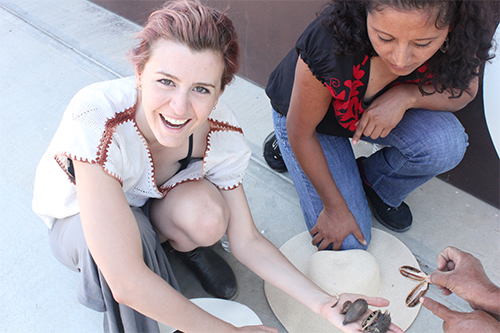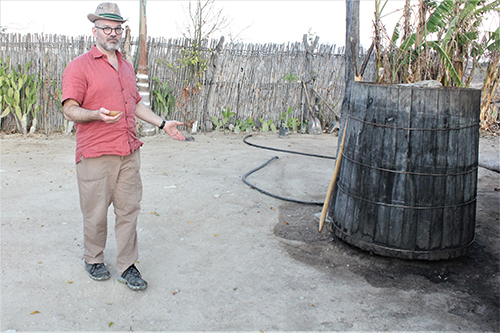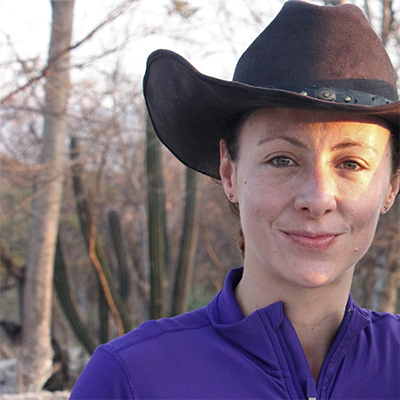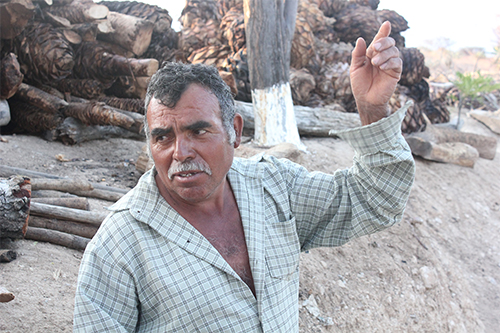Blasting down 135D from Mexico City to Oaxaca may well be the most thrilling/horrifying car ride you’ll ever take. For most of the trip, there are two lanes, one going in each direction, and a center lane, indicated with a four-foot “passing lane” for cars going in both directions. We saw many vehicles using this passing lane to zip around blind curves, others darting out and passing two or three cars before dropping into line just before their front bumper met oncoming vehicles. We saw several accidents: not fender-benders but, ghastly, bodies-on-the-road collisions, serious injuries and twisted metal.
By the time we got to Oaxaca, we were ready for a drink. That drink would be mezcal, though by regulation, it cannot be legally referred to as mezcal but rather “distilled agave spirits.”
In her magnificent “Divided Spirits: Tequila, Mezcal and the Politics of Production” (2015, University of California Press), Sarah Bowen explains that the institutions regulating mezcal “adopt a narrow and technical understanding of quality, one that focuses on maximizing economic efficiency and meeting the standards required for export markets” rather than “the perspectives of agave farmers, workers and small … mezcaleros.”
Because of what Bowen and others might consider unfairly restrictive standards on traditional practices, mezcaleros — people who’ve been producing mezcal for generations — must legally refer to their products not as “mezcal” but as “distilled agave spirits,” a term that generally applies to raicilla, bacanora, tequila and other products of the agave. This is a fine distinction that matters not at all to populations that for centuries have visited these small producers to buy mezcal for religious celebrations, quinceañeras, and other traditional social events in Oaxacan villages. To them, and to many of us, we still call it mezcal.
Andrea Hagan: From the Village of Wilmette to the Villages of Oaxaca
Our guide to some of these small villages was Andrea Hagan, born in the Chicago suburb of Wilmette, a New Trier graduate, now a resident of Oaxaca and owner of a tourism start-up called Mezcouting.

“Mezcouting,” explains Hagan, “was born out of a necessity of people asking about palenques (workshops where mezcal is made) and wanting to get to know the culture and the tradition surrounding mezcal production. I was taking people to palenques just to show them around, and the more people I was bringing, the more I could see that people were interested in learning more. So right now we’re bringing people to several different villages around Oaxaca, doing hands-on tours. You get to taste mezcal and you can even cut down the agaves with them.”
Bowen agrees with what Saveur magazine has called “a sort of gold rush in the Oaxacan hills, with importers combing the countryside for the best palenqueros (mezcal producers).” The popularity of mezcal, speculates Bowen, may be attributed to the current search for “authenticity” and the unique flavors typical of craft producers of beer and spirits.
Hagan guided us to Real Minero, in the town of Santa Catarina Minas, where they’re cultivating many different kinds of agave and producing mezcal. “If we don’t keep these plants alive,” says Real Minero’s Graciela Angeles, “we will lose them, and Oaxaca will lose some of its biodiversity.”

Dr. Richard Rhoda and Tony Burton explain in their book “Geo-Mexico: The Geography and Dynamics of Modern Mexico” (Sombrero Books, 2010) that Mexico is one of the six most biodiverse countries on the planet, and that Oaxaca is one of the most biodiverse states in Mexico. There are, for instance, around 200 different types of agave plant, and of those, more than two dozen are used to make mezcal. Tequila, on the other hand, is produced with only one type of agave: the blue agave.
With Hagan we visited Felix Angeles, a small mezcalero (and cousin of Graciela) who leverages the agave wealth of Oaxaca to produce distilled spirits from many different types of agave — Arroqueno, Espadin, Bicuixe and many others — that are used to produce a number of high-quality, hand-crafted spirits, each with a distinctive flavor. This variety distinguishes mezcal from tequila, which uses only the blue agave. Agave plants may need to grow in place, absorbing the flavors of the countryside, for up to 12 or more years, which means they’re more reflective of terroir than, say, whiskey, which is produced with grain that grows for only one season.
This is why, says Chicagoan and mezcal enthusiast Lou Bank, you have to age whiskey in barrels because “barrel aging is the only way to give it any flavor at all.” Bank doesn’t care much for barrel-aged spirits; for him, the wood flavor overwhelms the taste of the terroir. With agave spirits, those tastes, so reflective of place, are paramount.
Lou Bank: Agave is S.A.C.R.E.D.
Bank, like Hagan, is passionate when it comes to spreading the word about this spirit, which is why he founded a nonprofit organization called S.A.C.R.E.D.: Saving Agave for Culture, Recreation, Education and Development. As is explained on the S.A.C.R.E.D. website, “The (relative) boom in interest in agave spirits … has created an economic engine that is sparking enormous changes in the rural Mexican towns where they produce these traditional and artisanal spirits.”

In support of such efforts, Bank and S.A.C.R.E.D. have worked with Chicago’s Dark Matter Coffee to produce a coffee-infused mezcal, and with the restaurant Uncommon Ground to conduct dinners paired with mezcal. Bank conducts these mezcal tastings to generate funds for mezcal-related causes that include a library and greenhouses in Santa Catarina Minas.
The positive impact of mezcal’s popularity on small Mexican communities has also been recounted by Silvia Philion Munoz of Mezcaloteca Ranch in Miahuatlan, Oaxaca. Taking us on a tour of her property where many rare agave plants are cultivated and harvested, she told us, “There was a time when many young men left these small communities, but now they’re coming back. There are now jobs growing the agave and distilling mezcal.”

With Munoz, we paid a visit to Victor Ramos, a legendary mezcalero. When we pulled up to Ramos’ palenque, the sun was going down and Ramos was walking up from his field of agave, his brow glistening in the setting sunlight. Ramos still farms the agave himself, producing marvelous spirits in the old way: roasting the bulbous agave hearts in the ground, smashing them by tahona (a large stone wheel usually pulled by an ox), fermenting them using wild yeasts, and then distilling them in pots over a wood fire.

After we shared a few drinks of his mezcal — including an opening sip of puntas, a high-proof mezcal produced at the very beginning of the distillation process — we went to a small shed where he kept his mezcal, some in 3-gallon plastic jerry cans. We brought our own empty water bottles to transport many liters of mezcal back to the States. Bank even invested in several gallons of the spirit to be put into a glass jug and buried on Ramos’ property for several years. “You can keep it in the ground for one year, but two years is better,” Munoz told us, “and three years is best.” Somehow, even in glass, the mezcal is believed to be magically enhanced by spending a little more time in the darkness of Mother Earth.
Mezcal, clearly, is making its way into the mainstream of cocktail culture, and this “mezcal boom,” wrote Dana Goodyear in The New Yorker, “coincides with the popularity of farm-to-table food, and the advent of the bartender as an advocate for environmental and social justice.”
Right now, you can still visit Oaxaca and have some of the best mezcal in the world, made the traditional way. But that may be changing. With the need to produce more spirits, and perhaps someday even be certified and able to sell their mezcal in the States, mezcaleros are upgrading their operations to be more effective. Munoz herself is considering a motor-driven tahona instead of one driven by an animal; a small change, yes, but a somewhat disheartening sign that with every day, the old ways are changing.

David Hammond is Dining and Drinking Editor at Newcity and contributes to the Chicago Tribune and other publications. In 2004, he co-founded LTHForum.com, the 15,000 member food chat site; for several years he wrote weekly “Food Detective” columns in the Chicago Sun-Times; he writes weekly food columns for Wednesday Journal. He has written extensively about the culinary traditions of Mexico and Southeast Asia and contributed several chapters to “Street Food Around the World.”

